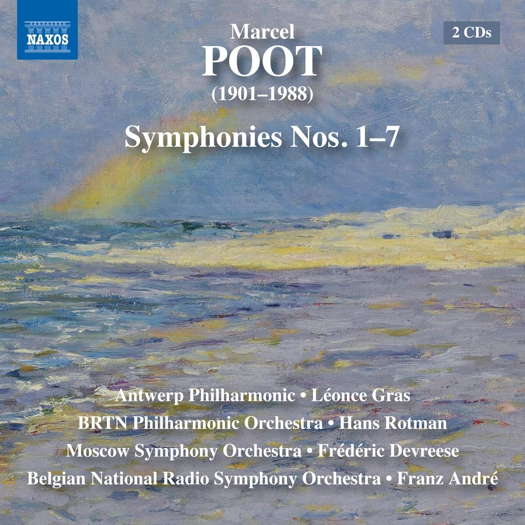 WORD SEARCH: Can you solve Allan Rae's classical music word search puzzles? We're currently publishing one per month.
WORD SEARCH: Can you solve Allan Rae's classical music word search puzzles? We're currently publishing one per month.
- clavichord
- Setrak Setrakian
- Vincent Novello
- Mendelssohn Bartholdy
- Keith Bramich
- Decca Music Group Ltd
- Gemma Summerfield
- Ava Dodd
 PODCAST: Join Jenna Orkin, Maria Nockin, John Daleiden, Gerald Fenech, Julian Jacobson, Patrick Maxwell, Giuseppe Pennisi and Mike Wheeler for a fascinating fifty-minute audio only programme.
PODCAST: Join Jenna Orkin, Maria Nockin, John Daleiden, Gerald Fenech, Julian Jacobson, Patrick Maxwell, Giuseppe Pennisi and Mike Wheeler for a fascinating fifty-minute audio only programme.

An Invaluable Collection
Symphonies by Marcel Poot, heard by GEOFF PEARCE
'... generally the playing and sound is very good.'
Marcel Poot (1901-1988) is an interesting Belgian composer whose music is generally characterised by his wit and exuberance. He wrote seven symphonies and these were evenly produced throughout his career. Whilst they were clearly written in the twentieth century, his music is tonal and rhythmic and there would be little to alienate listeners.
The First Symphony, written in 1929, is in three movements and right from the outset, the composer's youthful enthusiasm, wit and skill shows itself. He orchestrates well, the opening movement is cheerful and varied and the subject matter is clear. His influences are varied, yet his voice is individualistic. He is economical with his musical material and does not go into long developments. The influence of jazz is quite well felt. The second movement is tender and beautiful and quite simple, reminding me of sitting under a tree on a gentle summer's day. The programme notes say that this movement is an almost literal orchestration of his 1927 piano sonata.
Listen — Marcel Poot: Andante (Symphony No 1)
(CD1 track 2, 2:33-3:10) ℗ 1960, 1977, 1995-1996 Naxos Rights (Europe) Ltd :
The last movement is exuberant and quite boisterous, reminding me of the business of an urban area. Again, the influence of jazz, Stravinsky and Ravel is felt.
Listen — Marcel Poot: Rondo: Jazz - Allegro (Symphony No 1)
(CD1 track 3, 1:22-1:59) ℗ 1960, 1977, 1995-1996 Naxos Rights (Europe) Ltd :
The orchestra here is the BRTN Philharmonic Orchestra conducted by Hans Rotman.
The Second Symphony (1937) was written for the conductor Franz André and he performs it here with the Belgian Radio Symphony Orchestra. Recorded in 1960 but a new release on this album.
The first movement is again exuberant and filled with contrast: sometimes calm, and at others optimistic and powerfully assertive. For its age, the recording has come up quite well, but it is obvious that it is an older recording. This is not meant as a criticism, but the placement of microphones was very different in those days. The influence of jazz is perhaps less felt in this symphony than the previous one.
The second movement is serene for the most part, and there is some very fine playing, and it is enjoyable music. The woodwind, especially oboe and flute, seem to employ a rather fast vibrato, and I am wondering if this may be accentuated in the recording, given its age. This effect is also noted in the solo string writing too, but is a little less noticeable.
Listen — Marcel Poot: Andante tranquillo (Symphony No 2)
(CD1 track 5, 0:00-0:45) ℗ 1960, 1977, 1995-1996 Naxos Rights (Europe) Ltd :
The last movement starts off rather slowly and mysteriously, before a lively and brilliant fast section ensues. The composer contrasts various groups of instruments, to great effect, and the music maintains interest right to the end, although there is a sweeping rhapsodic section just before the middle of the movement.
The Third Symphony (1952) shows further evidence of Poot's growing powers as a composer. It starts and ends with a slow introduction which is heartfelt and lyrical, but quickly develops into a rather stormy fast movement that seems a mixture of anger and anguish. This does relax in a middle section, but only briefly before a fugal section, which starts softly but grows in power. The music's stormy nature never overpowers though, and the music returns to the introduction subject and ends very quietly.
The second movement starts with an elegiac theme which, whilst tonal, has a somewhat off-world character. This eventually evolves into a rather intense and faster middle section, that is somewhat ominous with the throbbing bass ostinato over which higher strings move, until some woodwind chords herald a quite intense brass outburst before the music subsides, and becomes gradually slower, until the ostinato figure ceases, then the calm of the opening movement gradually asserts itself again.
The last movement is again in a similar form than the previous two movements, in this case, a fast section with a slow middle and fast ending. This symphony overall is somewhat stormier than the two earlier ones, and at times somewhat despondent, but it is a gripping work to listen to.
Listen — Marcel Poot: Allegro vivo e resoluto (Symphony No 3)
(CD1 track 9, 5:53-6:35) ℗ 1960, 1977, 1995-1996 Naxos Rights (Europe) Ltd :
The second disc in this set contains the last four symphonies, a product of Poot's mature years and which were composed over a twelve year period.
The Fourth Symphony starts powerfully and immediately. The influence of jazz and composers of his early years has long gone, but the music is still very interesting, nevertheless, and quite unlike many of his contemporaries. In some ways, I would liken Poot's music of this period to the symphonies of Malcolm Arnold.
Listen — Marcel Poot: Allegro con fuoco (Symphony No 4)
(CD2 track 1, 0:00-0:46) ℗ 1960, 1977, 1995-1996 Naxos Rights (Europe) Ltd :
The second movement opens quietly with a solo flute over strings. It is rather ethereal in nature. There is a more intense middle section before the music returns to the original nature and themes of the opening. I find this a most satisfying movement.
The last movement of the symphony is jocular and spirited. The booklet enclosed with these symphonies gives quite a good general breakdown of these works, and the descriptions are easy to follow. I like this movement because of its concertante-like nature where the composer highlights various sections of the orchestra, and intersperses them with larger forces. He varies his material a lot in this movement, so the progression is always interesting.
Symphony No 5, composed in 1974, like all of the Poot symphonies, is in three movements. It is relatively short, at under six minutes, and contains five sections that combine towards the end. It opens almost in a driven Shostakovich-like fashion, full of a driving ostinato, which is punctuated with short brass chords, strong rhythms and shrieking woodwind. There is a lyrical middle section and then a short ending where the rhythmic and melodic earlier material is combined. Poot shows economical use of his material.
The second movement, like many of his second movements, starts off with a soulful and quite beautiful cantilena. This moves into a quicker section which becomes more forceful, and dispels the earlier quiet mood. In the quiet section there is some beautifully restrained playing, firstly in the violas and then with the clarinet, horn and bassoon. The middle section becomes fast and boisterous, and somewhat jocular with some delightful passages combining flute and oboes, before the original calm cantilena comes back and ends the movement calmly.
Listen — Marcel Poot: Adagio (Symphony No 5)
(CD2 track 5, 4:13-4:59) ℗ 1960, 1977, 1995-1996 Naxos Rights (Europe) Ltd :
The last movement is exciting and, like much of Poot's music, has strong rhythms. It is very spirited and contains some deft writing for all sections. This is most enjoyable, but I imagine it would have the performers sitting on the edges of their seats.
Symphony No 6, composed in 1978, is another work in the same vein as the previous two. It starts strongly and is quite varied again in material and mood. There is perhaps a little more soloistic writing for the various sections.
The second movement starts with an atmospheric brass introduction, answered by upper strings and various solo instruments. The violins then announce a tune which is taken up by the oboe. A new chorale-like section then opens up and gradually increases in speed and becomes more intense, before the brass herald in the chorale-like section before the momentum builds a little again and then the movement subsides to the original material and ends serenely.
Listen — Marcel Poot: Andante maestoso (Symphony No 6)
(CD2 track 8, 5:04-5:46) ℗ 1960, 1977, 1995-1996 Naxos Rights (Europe) Ltd :
The last movement starts off in a scherzo - the music is happy and upbeat generally. Poot shows keen orchestration skills and the music is engaging. There is a slower lyrical trio like section, that is interspersed with interjections from the opening. The original scherzo returns, and then the whole pace increases, propelling this movement to a triumphant ending.
Poot's last symphony was written in 1982 and shows remarkable energy and inventiveness for an eighty-year-old composer. The first movement is just over six minutes and starts with a short ostinato figure that gowns into a longer melodic idea, firstly in the violins and then fragments are enunciated by other sections. A solo timpani moves the music to a concertante like section, this increases in intensity and speed until a coda rounds off this movement.
The second movement begins with a broad string melody. After some slightly mysterious underpinning chords, the horn and bassoon introduce another section. The music then gains in intensity and speed for another section which winds down before recapitulating in a fashion and then closing with a small coda.
The last movement is happy and brief - a kind of celebratory movement that is full of positive energy. Even in a short movement such as this, Poot is able to provide contrasting sections that provide plenty of interest, such as in this movement with a lovely trombone section that is lyrical and slow, in contrast to the material around it.
Listen — Marcel Poot: Allegro impetuoso (Symphony No 7)
(CD2 track 12, 2:04-3:00) ℗ 1960, 1977, 1995-1996 Naxos Rights (Europe) Ltd :
Marcel Poot's music is very largely overlooked, and this is a great pity. He is a master craftsman, his music is engaging and he is quite an original voice. The recordings employ four different orchestras and conductors, and the second symphony recordings dates back to 1960, showing a different style and sound to the more modern offerings. I find this does not matter, as a collection of all the Poot symphonies together in one set is invaluable and generally the playing and sound is very good.
Copyright © 3 June 2021
Geoff Pearce,
Sydney, Australia

CD INFORMATION - MARCEL POOT: SYMPHONIES NOS 1-7
MORE CLASSICAL MUSIC ARTICLES ABOUT BELGIUM
MORE TWENTIETH CENTURY MUSIC ARTICLES


